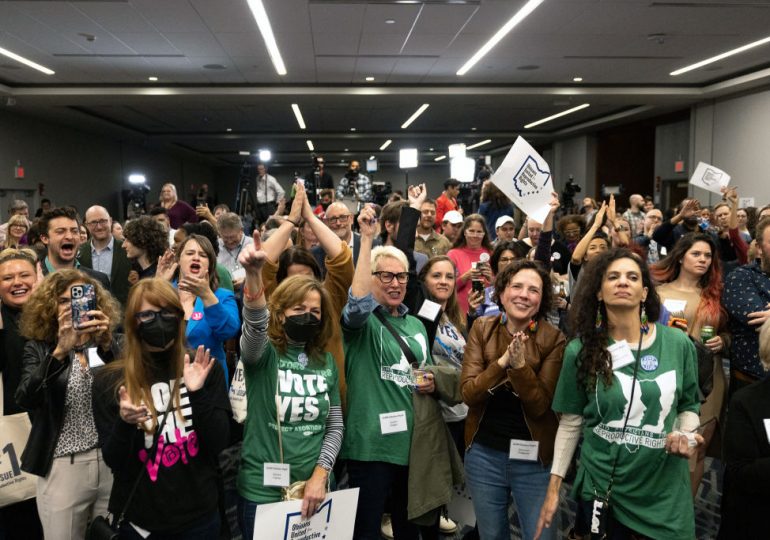On Tuesday, Ohio voters added language to their state constitution that protects the right to “make and carry out one’s own reproductive decisions.” The amendment allows an abortion ban after “fetal viability,” but with an exception for cases in which an abortion is “necessary to protect the pregnant patient’s life or health.”
[time-brightcove not-tgx=”true”]
The overwhelming vote, of 56.62% in favor and 43.38% against, demonstrates majority support for abortion rights and exemplifies the fact that this extends even to states dominated by Republicans. The Ohio GOP has won eight of the last nine gubernatorial elections, and the party has had unified control of state government since 2011. They used this power to stack the deck against the referendum; in August, they forced a vote on whether to raise the threshold for passing a constitutional amendment from a simple majority to 60%. Even after voters soundly rejected that measure, Republicans continued to spread misinformation about the abortion initiative and even paraphrased the language of the amendment in potentially misleading terms on the ballots voters received.
With this vote, Ohio becomes the fourth state since 2022 to pass a constitutional measure to safeguard abortion rights, and the seventh to use the referendum process to protect those rights in some way. The results are the latest evidence that bypassing state legislatures that are tilted against abortion rights with direct-to-the-people referendums is a winning strategy for preserving or enhancing reproductive freedom. But they also indicate that these state-by-state battles are wearying, expensive, and perhaps unsustainable. The history of these fights dating back to the 1960s highlights this duality: state-by-state campaigns can be inspiring and successful, but they’re also an endless game of whack-a-mole for advocates of reproductive rights—one that might not be winnable in the end.
In the late 1960s and into 1970, reproductive rights activists made substantial progress at the state level. They took advantage of shifting public opinion that went from majority opposition to legal abortion access to majority support.
State legislatures were slow to change policy in line with this shift. So feminists and their allies used every strategy and resource available to them, from mass organizing and demonstrations, to legislative lobbying and pressuring elected officials in their home districts, to encouraging medical, public health, and legal leaders to change the policies of their professional bodies to reflect the safety of legal abortion and the risks to pregnant women when the procedure was criminalized. They won reforms that expanded access to abortion in 13 states and made it mostly accessible in an additional four states.
New York State was the location of the biggest and most high-profile win. In July 1970, the state began to implement a transformative abortion law, which granted New Yorkers and anyone who could get to New York access to safe, legal, and somewhat affordable abortion care through the 24th week of a pregnancy. The win reflected the rising power of a coalition that joined activists for women’s rights with “Reform” Democrats like the Black Assemblyman Percy Sutton from Harlem, and Austrian Jewish refugee Assemblyman Franz Leichter, who worked together to pull the Democratic Party to the pro-civil rights left.
But things grew far more challenging for the movement after the victory in New York. Although public opinion kept moving in the direction of more liberal abortion laws, conservative lobbyists for the Catholic Church and other abortion opponents counter-mobilized aggressively and it became difficult to keep up. The momentum toward changing state policies halted, and the democratic process that had seemed to be working so well essentially stopped working. In addition to the New York victory, 1970 also saw Alaska and Hawaii loosen their abortion laws through legislative action, and activists in Washington state won a major reform via a hard-fought popular referendum campaign. But no other states moved forward over the next three years.
Even in New York, progress in making the state political system respond to what the people wanted was shaky at best. This was in part a product of the exhaustion of feminist and “Reform” forces, who had given their all to the effort to change the law. Meanwhile, conservative lobbyists, representing the Catholic hierarchy and to a lesser degree evangelical Protestants and Orthodox Jews, had deep pockets to fund their work and the imagery of tradition and “family values” on their side.
The upstate New York Democratic legislator whose vote had been decisive in the pro-abortion rights vote of 1970 lost his seat and his political career soon thereafter. This served as a warning to other politicians about what might happen if they crossed anti-abortion forces. In 1971, New York legislators backed by conservatives on the outside introduced 30 different bills in the state legislature to restrict abortion access. Feminists and liberals who favored easing abortion access had to beat back each of these—even as they were trying, unsuccessfully, to improve on the 1970 law.
Read more: Ohio Votes to Protect Abortion Access in Major Statewide Victory for Reproductive Rights
In the crucible of these fights, conservative Republicans learned how to use their clout to grind the machinery of government to a halt. Five intransigent senators, who refused to approve the state budget, got the liberal administration of Governor Nelson Rockefeller to strip abortion procedures from the health insurance coverage low-income people received through Medicaid. This cut was reversed by the courts in the short run, but eventually became the model for the national Hyde Amendment, which for almost five decades has forbidden the spending of any federal Medicaid dollars on abortion procedures.
In 1972, anti-abortion advocates in New York almost won—despite public opinion being staunchly against them. Only a veto by Gov. Rockefeller saved the 1970 abortion reform law from a full repeal.
These events forced advocates to conclude that the state-by-state approach was not sustainable. They had to pivot to an effort to change national law—once considered a pie-in-the-sky position within the feminist movement. Working with activists in the Women’s National Abortion Action Coalition, Representative Bella Abzug (D-N.Y.) introduced national legislation to protect abortion rights.
At the same time, feminist litigators were at work in the lower federal courts, eventually believing that they might be able to win in the U.S. Supreme Court. Quietly, some of the justices on the Court seem to have come to the same conclusion: Justice Harry Blackmun kept in his files both a New York Times article that reported on the latest polls revealing majority support for abortion rights, including among lay Catholics, and an article from the journal Science News arguing that the roiling, back-and-forth battles over abortion in New York State proved “that a definitive ruling from the Supreme Court is necessary.”
In 1973, this change in strategy led to Blackmun’s opinion in Roe v. Wade, which determined that the Constitution protected a right to an abortion through the second trimester.
The Court’s decision to overturn Roe in 2022 reignited a state-by-state strategy to protect abortion rights. Such campaigns remain exhausting and expensive, even as they’ve proved successful. Ohioans for Reproductive Rights, the umbrella organization pushing for the amendment, reported spending $26 million since Labor Day alone, not including what they spent to fight the August initiative. This represents an expenditure of resources and person-power that might be unsustainable. As in the past, the resources it requires to make policy match public opinion—and to keep fighting essentially the same battles repeatedly—illustrates the benefit in seeking a national solution.
That’s especially true because only 26 states allow popular referendums like Tuesday’s vote. And several of the states that don’t—including Texas, Louisiana, and Alabama—have the most restrictive abortion laws in the country. Gerrymandering and geographic polarization guarantee that Republican legislators in these states care primarily about what the small sliver of older, whiter, more religious, more extreme voters who show up for primaries think and make victory highly unlikely for pro-reproductive rights forces.
This reality will thwart the will of the majority that wants to be protect reproductive rights unless Congress enacts national protections. House Democrats passed a bill to do just that in 2021 and 2022, but it failed to win the 60 votes necessary to overcome a Republican filibuster in the Senate. It’s easy to say that state-level debates are a key part of democracy. But when the system is structured in such a way that legislatures can ignore the will of the people, and non-stop campaigns require tens of millions of dollars, waging a state-by-state battle simply means that millions of people lose control of their reproductive health. That’s the lesson of history.
Felicia Kornbluh is the author of A Woman’s Life is a Human Life: My Mother, Our Neighbor, and the Journey from Reproductive Rights to Reproductive Justice (Grove Press), the paperback edition of which is now available for preorder. She is a professor of history and of gender, sexuality, and women’s studies at the University of Vermont.
Made by History takes readers beyond the headlines with articles written and edited by professional historians. Learn more about Made by History at TIME here.
Leave a comment
















